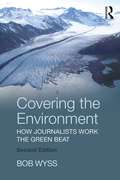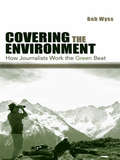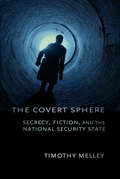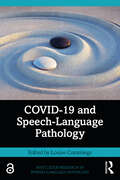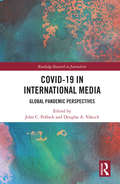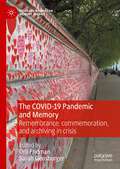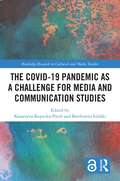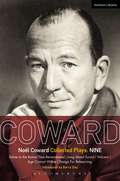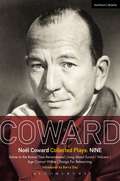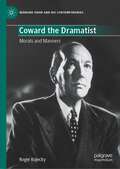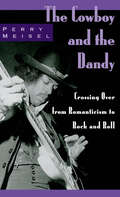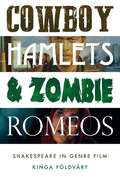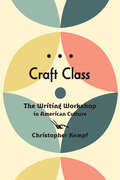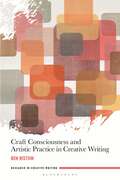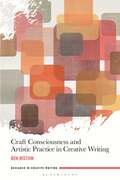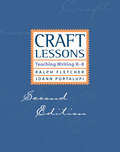- Table View
- List View
Covering the Environment: How Journalists Work the Green Beat
by Bob WyssThis practical primer explains the primary issues in writing about the environment, identifies who to go to and where to find sources, and offers examples of writing and reporting the beat. Observations and story excerpts from experienced journalists provide real-world context both for those in the U.S. as well as internationally. Practice story assignments, resources, and a glossary of critical terms gives budding journalists all the tools needed to cover the green beat. Updated with detailed coverage of how companies and climate change have evolved over the past decade, this second edition expands upon the digital sphere and the myriad ways that deadline, multimedia and mobile reporting have changed environmental journalism. Including consideration of issues such as the water crisis in Flint, Michigan, and the GMO controversy, this new edition provides a fresh take on the green beat with a newly organized table of contents and a guide to freelance and entrepreneurial journalism anywhere in the world. Contents include: • an overview and history of the environment and journalism, spotlighting the most significant issues in the beat; • guidance on understanding environmental and health science, ranging from issues of risk, to scientific research and studies, to interviewing scientists; • insights into government and regulatory communities and environmental advocates on all sides of the political spectrum and internationally; • assistance in accessing public records and conducting digital and computer-assisted reporting; • guidance in writing the story for print, broadcast and internet audiences; • an examination of the future of journalism and news coverage of the environment in the U.S. and throughout the world.
Covering the Environment: How Journalists Work the Green Beat
by Bob WyssThis practical primer explains the primary issues in writing about the environment, identifies who to go to and where to find sources, and offers examples of writing and reporting the beat. Observations and story excerpts from experienced journalists provide real-world context both for those in the U.S. as well as internationally. Practice story assignments, resources, and a glossary of critical terms gives budding journalists all the tools needed to cover the green beat. Updated with detailed coverage of how companies and climate change have evolved over the past decade, this second edition expands upon the digital sphere and the myriad ways that deadline, multimedia and mobile reporting have changed environmental journalism. Including consideration of issues such as the water crisis in Flint, Michigan, and the GMO controversy, this new edition provides a fresh take on the green beat with a newly organized table of contents and a guide to freelance and entrepreneurial journalism anywhere in the world. Contents include: • an overview and history of the environment and journalism, spotlighting the most significant issues in the beat; • guidance on understanding environmental and health science, ranging from issues of risk, to scientific research and studies, to interviewing scientists; • insights into government and regulatory communities and environmental advocates on all sides of the political spectrum and internationally; • assistance in accessing public records and conducting digital and computer-assisted reporting; • guidance in writing the story for print, broadcast and internet audiences; • an examination of the future of journalism and news coverage of the environment in the U.S. and throughout the world.
Covering the Environment: How Journalists Work the Green Beat
by Robert L. WyssCovering the Environment serves as a primer for future and current journalists reporting on environmental issues across all types of media. This practical resource explains the primary issues in writing on the environment, identifies who to go to and where to find sources, and offers examples on writing and reporting the beat. It also provides background to help environmental journalists identify their audiences and anticipate reactions to environmental news. This primer emphasizes the role of environmental journalists not as environmental advocates but as reporters attempting to accurately and fairly report the news. Contents include: An overview and history of the environment and journalism, spotlighting the most significant issues in the beat Guidance on understanding environmental and health science, ranging from issues of risk, to scientific research and studies, to interviewing scientists Insights into government and regulatory communities and environmental advocates on all sides of the political spectrum Assistance in accessing public records and conducting computer-assisted reporting Guidance in writing the story for print, broadcast and Internet audiences An examination of the future of journalism and coverage of the environment. Observations and story excerpts from experienced journalists provide a "real world" component, illuminating the practice of environmental journalism. Additional features in each chapter include study questions, story assignments and resources for additional information. The book also provides a glossary of environmental, science, regulator and journalism terms, as well as a reference section and index. This resource has been developed to train advanced undergraduate and graduate journalism students to cover the science and environment community, writing print and broadcast stories to a general audience. It also serves as a guide for working journalists who cover the environment in their work.
The Covert Sphere: Secrecy, Fiction, and the National Security State
by Timothy MelleyIn December 2010 the U.S. Embassy in Kabul acknowledged that it was providing major funding for thirteen episodes of Eagle Four—a new Afghani television melodrama based loosely on the blockbuster U.S. series 24. According to an embassy spokesperson, Eagle Four was part of a strategy aimed at transforming public suspicion of security forces into something like awed respect. Why would a wartime government spend valuable resources on a melodrama of covert operations? The answer, according to Timothy Melley, is not simply that fiction has real political effects but that, since the Cold War, fiction has become integral to the growth of national security as a concept and a transformation of democracy. In The Covert Sphere, Melley links this cultural shift to the birth of the national security state in 1947. As the United States developed a vast infrastructure of clandestine organizations, it shielded policy from the public sphere and gave rise to a new cultural imaginary, "the covert sphere." One of the surprising consequences of state secrecy is that citizens must rely substantially on fiction to "know," or imagine, their nation’s foreign policy. The potent combination of institutional secrecy and public fascination with the secret work of the state was instrumental in fostering the culture of suspicion and uncertainty that has plagued American society ever since—and, Melley argues, that would eventually find its fullest expression in postmodernism. The Covert Sphere traces these consequences from the Korean War through the War on Terror, examining how a regime of psychological operations and covert action has made the conflation of reality and fiction a central feature of both U.S. foreign policy and American culture. Melley interweaves Cold War history with political theory and original readings of films, television dramas, and popular entertainments—from The Manchurian Candidate through 24—as well as influential writing by Margaret Atwood, Robert Coover, Don DeLillo, Joan Didion, E. L. Doctorow, Michael Herr, Denis Johnson, Norman Mailer, Tim O’Brien, and many others.
COVID-19 and Speech-Language Pathology (Routledge Research in Speech-Language Pathology)
by Louise CummingsThis collection is the first of its kind to examine the impact of the COVID-19 pandemic on the caseloads and clinical practice of speech-language pathologists. The volume synthesises existing data on the wide-ranging effects of COVID-19 on the communication, swallowing, and language skills of individuals with COVID infection. Featuring perspectives of scholars and practitioners from around the globe, the book examines the ways in which clinicians have had to modify their working practices to prioritise patient and clinician safety, including the significant increase in the use of telepractice during the pandemic. The volume also reflects on changes in training and education which have seen educators in the field redesign their clinical practicum in order to best prepare students for professional practice in an age of COVID-19 and beyond, as the field continues to grapple with the long-term effects of the pandemic. Offering a holistic treatment of the impact of COVID-19 on the work of speech-language pathologists, this book will be of interest to students, researchers, and clinicians working in the discipline. Chapters 5, 6, 10, and 13 of this book are freely available as downloadable Open Access PDFs under a Creative Commons Attribution-Non Commercial-No Derivatives 4.0 license available at http://www.taylorfrancis.com
COVID-19 and Speech-Language Pathology (Routledge Research in Speech-Language Pathology)
by Louise CummingsThis collection is the first of its kind to examine the impact of the COVID-19 pandemic on the caseloads and clinical practice of speech-language pathologists. The volume synthesises existing data on the wide-ranging effects of COVID-19 on the communication, swallowing, and language skills of individuals with COVID infection. Featuring perspectives of scholars and practitioners from around the globe, the book examines the ways in which clinicians have had to modify their working practices to prioritise patient and clinician safety, including the significant increase in the use of telepractice during the pandemic. The volume also reflects on changes in training and education which have seen educators in the field redesign their clinical practicum in order to best prepare students for professional practice in an age of COVID-19 and beyond, as the field continues to grapple with the long-term effects of the pandemic. Offering a holistic treatment of the impact of COVID-19 on the work of speech-language pathologists, this book will be of interest to students, researchers, and clinicians working in the discipline. Chapters 5, 6, 10, and 13 of this book are freely available as downloadable Open Access PDFs under a Creative Commons Attribution-Non Commercial-No Derivatives 4.0 license available at http://www.taylorfrancis.com
COVID-19 in International Media: Global Pandemic Perspectives (Routledge Research in Journalism)
by John C. Pollock; Douglas A. VakochCovid-19 in International Media: Global Pandemic Responses is one of the first books uniting an international team of scholars to investigate how media address critical social, political, and health issues connected to the 2020-21 COVID-19 outbreak. The book evaluates unique civic challenges, responsibilities, and opportunities for media worldwide, exploring pandemic social norms that media promote or discourage, and how media serve as instruments of social control and resistance, or of cooperation and representation. These chapters raise significant questions about the roles mainstream or citizen journalists or netizens play or ought to play, enlightening audiences successfully about scientific information on COVID-19 in a pandemic that magnifies social inequality and unequal access to health care, challenging popular beliefs about health and disease prevention and the role of government while the entire world pays close attention. This book will be of interest to students and faculty of communication studies and journalism, departments of public health, sociology, and social marketing.
COVID-19 in International Media: Global Pandemic Perspectives (Routledge Research in Journalism)
by John C. Pollock Douglas A. VakochCovid-19 in International Media: Global Pandemic Responses is one of the first books uniting an international team of scholars to investigate how media address critical social, political, and health issues connected to the 2020-21 COVID-19 outbreak. The book evaluates unique civic challenges, responsibilities, and opportunities for media worldwide, exploring pandemic social norms that media promote or discourage, and how media serve as instruments of social control and resistance, or of cooperation and representation. These chapters raise significant questions about the roles mainstream or citizen journalists or netizens play or ought to play, enlightening audiences successfully about scientific information on COVID-19 in a pandemic that magnifies social inequality and unequal access to health care, challenging popular beliefs about health and disease prevention and the role of government while the entire world pays close attention. This book will be of interest to students and faculty of communication studies and journalism, departments of public health, sociology, and social marketing.
The COVID-19 Pandemic and Memory: Remembrance, commemoration, and archiving in crisis (Palgrave Macmillan Memory Studies)
by Orli Fridman Sarah GensburgerThis book offers a platform for the analysis of commemorative and archiving practices as they were shaped, expanded, and developed during the Covid-19 lockdown periods in 2020 and the years that followed. By offering an extensive global view of these changes as well as of the continuities that went with them, the book enters a dialogue with what has emerged as an initial response to the pandemic and the ways in which it has affected memory and commemoration.The book aims to critically and empirically engage with this abundance of memory to understand both memorialization of the pandemic and commemoration during the pandemic: what happened then to commemorative practices and rituals around the world? How has the Covid-19 pandemic been archived and remembered? What will remembering it actually entail, and what will it mean in the future? Where did the Covid memory boom come from? Who was behind it, how did it emerge, and in what socialconfigurations did it evolve?
The Covid-19 Pandemic as a Challenge for Media and Communication Studies (Routledge Research in Cultural and Media Studies)
by Katarzyna Kopecka-PiechThis truly interdisciplinary volume brings together a diverse group of scholars to explore changes in the significance of media and communication in the era of pandemic. The book answers two interrelated questions: how media and communication reality changed during the first wave of the COVID-19 pandemic, and how media and communication were effectively studied during this time. The book presents changes in media and communication in three areas: media production, media content, and media usage contexts. It then describes the theoretical and practical, methodological, technical, organizational, and ethical challenges in conducting research in circumstances of sudden change in research conditions, emergency situations and developing crises. Drawing on various theoretical studies and empirical research, the volume illustrates the principles and results of applying diverse research methods to the changing role of media in a pandemic and offers good practices and guidance to address the problems in implementing research projects in a time of sudden difficulties and challenges. This diverse and interdisciplinary book will be of significance to scholars and researchers in media studies, communication studies, research methods, sociology, anthropology, and cultural studies.
The Covid-19 Pandemic as a Challenge for Media and Communication Studies (Routledge Research in Cultural and Media Studies)
by Katarzyna Kopecka-Piech Bart 322 Omiej 321 ÓdzkiThis truly interdisciplinary volume brings together a diverse group of scholars to explore changes in the significance of media and communication in the era of pandemic. The book answers two interrelated questions: how media and communication reality changed during the first wave of the COVID-19 pandemic, and how media and communication were effectively studied during this time. The book presents changes in media and communication in three areas: media production, media content, and media usage contexts. It then describes the theoretical and practical, methodological, technical, organizational, and ethical challenges in conducting research in circumstances of sudden change in research conditions, emergency situations and developing crises. Drawing on various theoretical studies and empirical research, the volume illustrates the principles and results of applying diverse research methods to the changing role of media in a pandemic and offers good practices and guidance to address the problems in implementing research projects in a time of sudden difficulties and challenges. This diverse and interdisciplinary book will be of significance to scholars and researchers in media studies, communication studies, research methods, sociology, anthropology, and cultural studies.
COVID-19 und die Sportkommunikation: Der Einfluss der Corona-Pandemie auf Sport, Medien und Journalismus
by Jörg-Uwe Nieland Thomas HorkyCOVID-19 hat die Sportkommunikation nachhaltig verändert. Der Band bietet empirische Analysen, Einschätzungen und theoretische Ansätze sowie Erfahrungsberichte aus der Praxis zum Einfluss der Corona-Pandemie auf Medien, Journalismus und Sport. Aus unterschiedlichen Perspektiven schauen Wissenschaftlerinnen und Wissenschaftler sowie Personen aus der Praxis auf die Veränderungen in verschiedenen Medien- und Sportorganisationen sowie den Wandel von Produktions- und Arbeitsbedingungen innerhalb der Sportkommunikation. Gleichzeitig lassen sich erste Prognosen für einen Ausblick auf die Zukunft des Mediensports ableiten.
Coward Plays: Salute to the Brave/Time Remembered; Long Island Sound; Volcano; Age Cannot Wither; Design For Rehearsing (World Classics)
by Noël CowardCoward Plays: 9 offers up a fascinating selection of Noël Coward's lesser-known works. Salute to the Brave/Time Remembered (1940) follows Leila Heseldyne after she has fled to America, leaving a war-torn Britain and her husband behind; Long Island Sound(1947) sees a writer coerced into a riotous flock of high flying society people with turbulent results; and Volcano (1957) depicts a volcanic eruption as it punctuates the dubious conduct of six individuals on a fictional South Sea island. This volume also includes Design for Rehearsing (1933) was Coward's private satire on the way he , Alfred Lunt and Lynn Fontanne worked on Design for Living. Age Cannot Wither (1967), Coward's last and unfinished play completes the collection as it portrays the boozy reunion of three women in their sixties, who meet without fail every year to reminisce. Together, these works offer a new and intriguing insight into Coward the playwright and his oeuvre that extends well beyond his most well-known works such as Private Lives, Blithe Spirit and Hay Fever. The volume is introduced by Coward expert and scholar Barry Day.
Coward Plays: Salute to the Brave/Time Remembered; Long Island Sound; Volcano; Age Cannot Wither; Design For Rehearsing (World Classics)
by Noël CowardCoward Plays: 9 offers up a fascinating selection of Noël Coward's lesser-known works. Salute to the Brave/Time Remembered (1940) follows Leila Heseldyne after she has fled to America, leaving a war-torn Britain and her husband behind; Long Island Sound(1947) sees a writer coerced into a riotous flock of high flying society people with turbulent results; and Volcano (1957) depicts a volcanic eruption as it punctuates the dubious conduct of six individuals on a fictional South Sea island. This volume also includes Design for Rehearsing (1933) was Coward's private satire on the way he , Alfred Lunt and Lynn Fontanne worked on Design for Living. Age Cannot Wither (1967), Coward's last and unfinished play completes the collection as it portrays the boozy reunion of three women in their sixties, who meet without fail every year to reminisce. Together, these works offer a new and intriguing insight into Coward the playwright and his oeuvre that extends well beyond his most well-known works such as Private Lives, Blithe Spirit and Hay Fever. The volume is introduced by Coward expert and scholar Barry Day.
Coward the Dramatist: Morals and Manners (Bernard Shaw and His Contemporaries)
by Roger KojeckyDiscussions of Coward’s achievement in the theatre between 1920 and 1966 have tended to stay with the colourful biography. The more analytical literary approach adopted here places Coward’s success in its wider theatrical context, making the connections with the work of other dramatists. He developed his technique according to what worked with theatre audiences. Taking up the well-made play, he brought in a more colloquial dialogue, explored, for instance, the morality and psychology of marriage and free love, and frequently exploited the dramatic possibilities of characters grouped into two camps. The book considers both the ‘pleasant’ and ‘unpleasant’ plays (to use the Shavian terms), and the episodic patriotic plays. It Includes Coward’s ambivalent approach to the ‘theatre of war’ in the 20th century. (123)
The Cowboy and the Dandy: Crossing Over from Romanticism to Rock and Roll
by Perry MeiselWhat is rock and roll and where does it come from? In this adventurous new study of music, literature, and culture, Perry Meisel shows how rock and roll joins Romanticism and the blues tradition by focusing on the preoccupation with boundaries that are common to both--the boundaries between freedom and irony, country and city, and cowboy and dandy. Meisel traces the emergence of rock and roll out of jazz and Romantic culture alike as he examines, in a series of juxtaposed chapters, rhythm and blues, Emerson and the cowboy, urban blues, the dandy and psychedelia, Willa Cather, Miles Davis, Virginia Woolf, and 1960s rock. In the process, Meisel shows how the presumable difference between high and mass or pop culture disappears when both turn out to have similar structures. He also reveals how canons emerge inevitably within all traditions rather than being imposed upon them from without.
Cowboy Hamlets and zombie Romeos: Shakespeare in genre film (Manchester University Press)
by Kinga FöldváryThe book presents a systematic method of interpreting Shakespeare film adaptations based on their cinematic genres. Its approach is both scholarly and reader-friendly, and its subject is fundamentally interdisciplinary, combining the findings of Shakespeare scholarship with film and media studies, particularly genre theory. The book is organised into six large chapters, discussing films that form broad generic groups. Part I looks at three genres from the classical Hollywood era (western, melodrama and gangster-noir), while Part II deals with three contemporary blockbuster genres (teen film, undead horror and biopic). Beside a few better-known examples of mainstream cinema, the volume also highlights the Shakespearean elements in several nearly forgotten films, bringing them back to critical attention.
Cowboy Hamlets and zombie Romeos: Shakespeare in genre film (Manchester University Press)
by Kinga FöldváryThe book presents a systematic method of interpreting Shakespeare film adaptations based on their cinematic genres. Its approach is both scholarly and reader-friendly, and its subject is fundamentally interdisciplinary, combining the findings of Shakespeare scholarship with film and media studies, particularly genre theory. The book is organised into six large chapters, discussing films that form broad generic groups. Part I looks at three genres from the classical Hollywood era (western, melodrama and gangster-noir), while Part II deals with three contemporary blockbuster genres (teen film, undead horror and biopic). Beside a few better-known examples of mainstream cinema, the volume also highlights the Shakespearean elements in several nearly forgotten films, bringing them back to critical attention.
Cowley's Essays
by Abraham CowleyThe calm spirit of Cowley's "Essays" was in all his life. As he tells us in his Essay "On Myself," even when he was a very young boy at school, instead of running about on holidays and playing with his fellows, he was wont to steal from them and walk into the fields, either alone with a book or with some one companion, if he could find any of the same temper.
Coyer and the Enlightenment (Oxford University Studies in the Enlightenment #123)
by Leonard AdamsThe Oxford University Studies in the Enlightenment series, previously known as SVEC (Studies on Voltaire and the Eighteenth Century), has published over 500 peer-reviewed scholarly volumes since 1955 as part of the Voltaire Foundation at the University of Oxford. International in focus, Oxford University Studies in the Enlightenment volumes cover wide-ranging aspects of the eighteenth century and the Enlightenment, from gender studies to political theory, and from economics to visual arts and music, and are published in English or French.
Craft Class: The Writing Workshop in American Culture
by Christopher KempfThe hidden history of the creative writing workshop and the socioeconomic consequences of the craft labor metaphor.In a letter dated September 1, 1912, drama professor George Pierce Baker recommended the term "workshop" for an experimental course in playwriting he had been planning with former students at Harvard and Radcliffe. This was the first time that term, now ubiquitous, was used in the context of creative writing pedagogy. Today, the MFA (master of fine arts) industry is a booming one, with more than 200 programs and thousands of residencies and conferences for aspiring writers nationwide. Almost all of these offerings operate on the workshop model.In Craft Class, Christopher Kempf argues that the primary institutional form of creative writing studies, the workshop, has remained invisible before our scholarly eyes. While Baker and others marshaled craft toward economic critique, craft pedagogies consolidated the authority of elite educational institutions as the MFA industry grew. Transcoding professional-managerial soft skills—linguistic facility, social and emotional discernment, symbolic fluency—in the language of manual labor, the workshop nostalgically invokes practices that the university itself has rendered obsolete. The workshop poem or short story thus shares discursive space with the craft IPA or hand-loomed Pottery Barn rug—a space in which one economic practice rewrites itself in the language of another, just as right-wing corporatism continuously rewrites itself in the language of populism.Delineating an arc that extends from Boston's fin de siècle Society of Arts and Crafts through 1930s proletarian workshops to the pedagogies of Black Mountain College and the postwar MFA, Craft Class reveals how present-day creative writing restructures transhistorical questions of labor, education, and aesthetic and economic production. With the rise of the workshop in American culture, Kempf shows, manual and mental labor have been welded together like steel plates. What fissures does that weld seal shut? And on whose behalf does the poet punch in?
Craft Class: The Writing Workshop in American Culture
by Christopher KempfThe hidden history of the creative writing workshop and the socioeconomic consequences of the craft labor metaphor.In a letter dated September 1, 1912, drama professor George Pierce Baker recommended the term "workshop" for an experimental course in playwriting he had been planning with former students at Harvard and Radcliffe. This was the first time that term, now ubiquitous, was used in the context of creative writing pedagogy. Today, the MFA (master of fine arts) industry is a booming one, with more than 200 programs and thousands of residencies and conferences for aspiring writers nationwide. Almost all of these offerings operate on the workshop model.In Craft Class, Christopher Kempf argues that the primary institutional form of creative writing studies, the workshop, has remained invisible before our scholarly eyes. While Baker and others marshaled craft toward economic critique, craft pedagogies consolidated the authority of elite educational institutions as the MFA industry grew. Transcoding professional-managerial soft skills—linguistic facility, social and emotional discernment, symbolic fluency—in the language of manual labor, the workshop nostalgically invokes practices that the university itself has rendered obsolete. The workshop poem or short story thus shares discursive space with the craft IPA or hand-loomed Pottery Barn rug—a space in which one economic practice rewrites itself in the language of another, just as right-wing corporatism continuously rewrites itself in the language of populism.Delineating an arc that extends from Boston's fin de siècle Society of Arts and Crafts through 1930s proletarian workshops to the pedagogies of Black Mountain College and the postwar MFA, Craft Class reveals how present-day creative writing restructures transhistorical questions of labor, education, and aesthetic and economic production. With the rise of the workshop in American culture, Kempf shows, manual and mental labor have been welded together like steel plates. What fissures does that weld seal shut? And on whose behalf does the poet punch in?
Craft Consciousness and Artistic Practice in Creative Writing (Research in Creative Writing)
by Ben RistowCraft lives inside the artist, and it operates in the mind, not in standards or techniques. Creative writers navigate thresholds in consciousness as they develop their arts practice. Craft Consciousness and Artistic Practice in Creative Writing explores what it is to be an artist as it traces radical, feminist, and culturally embedded traditions in craft. The new term "craft consciousness" identifies the nexus from which writers explore making processes and practitioner knowledge. Writers, as with all artists, create and reimagine themselves anew, and it is in this perpetual state of becoming that they find ways to enlarge their sense of artistry through an exploration of forms, processes, and mediums beyond the written word.For writers, this book initiates a reexamination of the mission of creative writing through disrupting patriarchal, racist, colonialist, ableist, and capitalist associations with dominant craft. Drawing from twenty-five interviews with living artists outside of writing and in a host of fields from conceptual art to leatherwork and dance, the book shines a light on how the processes associated with craft are embodied. Craft is an internalized matrix; it need not be commodified for the marketplace or codified in the standards necessitated by institutions of higher education. By redesigning writing workshops and MFA/PhD programs through craft consciousness, new potentials and collaborations emerge, and it becomes more conceivable to imagine dynamic, inclusive relationships between writers, scientists, and other artists.
Craft Consciousness and Artistic Practice in Creative Writing (Research in Creative Writing)
by Ben RistowCraft lives inside the artist, and it operates in the mind, not in standards or techniques. Creative writers navigate thresholds in consciousness as they develop their arts practice. Craft Consciousness and Artistic Practice in Creative Writing explores what it is to be an artist as it traces radical, feminist, and culturally embedded traditions in craft. The new term "craft consciousness" identifies the nexus from which writers explore making processes and practitioner knowledge. Writers, as with all artists, create and reimagine themselves anew, and it is in this perpetual state of becoming that they find ways to enlarge their sense of artistry through an exploration of forms, processes, and mediums beyond the written word.For writers, this book initiates a reexamination of the mission of creative writing through disrupting patriarchal, racist, colonialist, ableist, and capitalist associations with dominant craft. Drawing from twenty-five interviews with living artists outside of writing and in a host of fields from conceptual art to leatherwork and dance, the book shines a light on how the processes associated with craft are embodied. Craft is an internalized matrix; it need not be commodified for the marketplace or codified in the standards necessitated by institutions of higher education. By redesigning writing workshops and MFA/PhD programs through craft consciousness, new potentials and collaborations emerge, and it becomes more conceivable to imagine dynamic, inclusive relationships between writers, scientists, and other artists.
Craft Lessons: Teaching Writing K-8
by Ralph Fletcher JoAnn PortalupiSince its publication in 1998 Craft Lessons has become a staple in the writing classroom of both new and experienced teachers. Authors Ralph Fletcher and JoAnn Portalupi recognized the need for a succinct resource and teamed together to write the second edition of Craft Lessons: Teaching Writing K-8 . Teachers pressed for time will appreciate the practical lessons and instructional language geared to three grade level groupings: K-2, 3-4, and 5-8. This edition includes: 17 brand new lessons; mini lessons designed from teachers&’ comments about what is observed students&’ writing Revisions to other craft lessons and the resource materials sections have been expanded New ways to approach teaching using elements of craft and the reading-writing connection A subject index to find specific craft lessons with ease The authors&’ thoughts about how craft lessons fit into their newest thinking about the qualities of writing: Ideas, Design, Language, and Presentation The 95 lessons in this book provide a wealth of information for teaching leads, character, endings, stronger verbs, and much more. This new edition reestablishes Craft Lessons as the crucial desert island book for harried writing teachers everywhere
